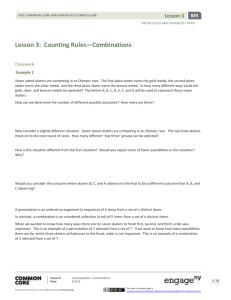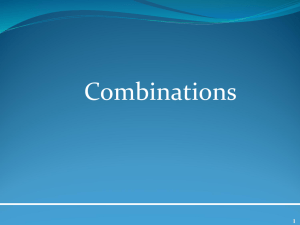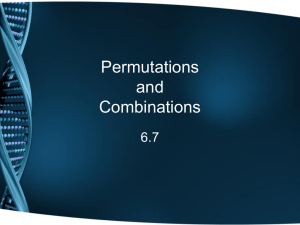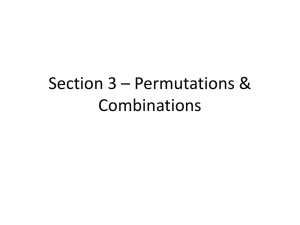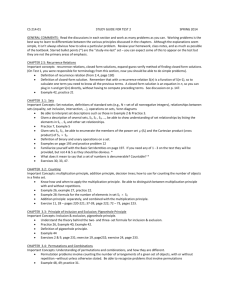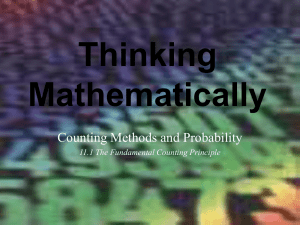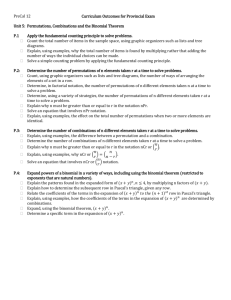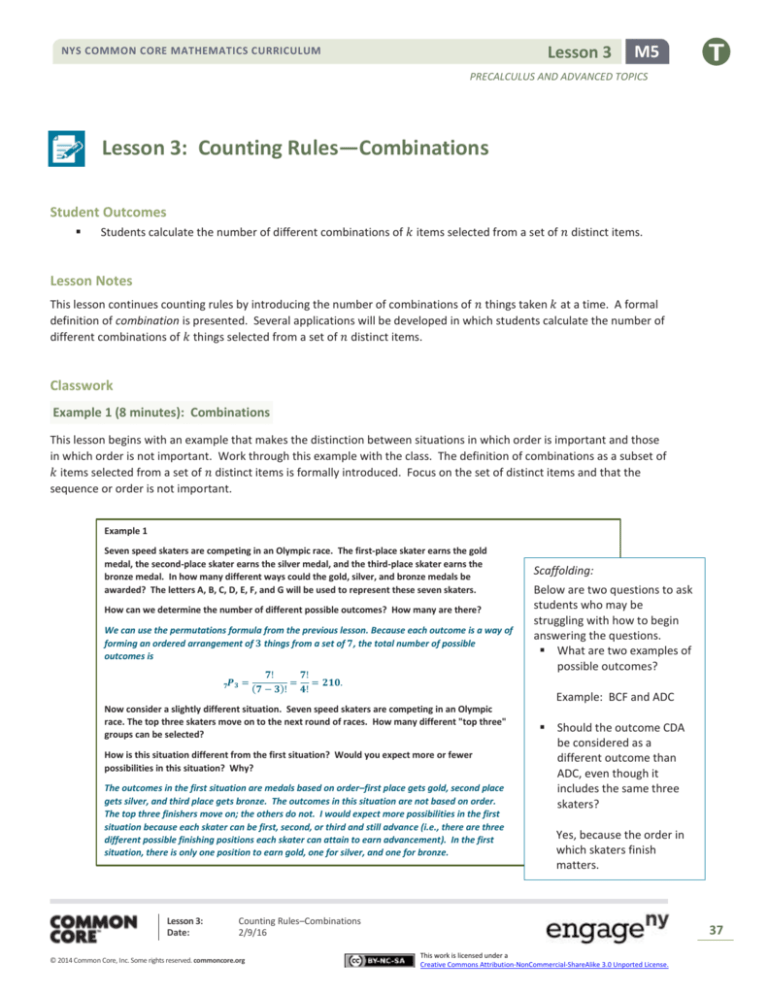
Lesson 3
NYS COMMON CORE MATHEMATICS CURRICULUM
M5
PRECALCULUS AND ADVANCED TOPICS
Lesson 3: Counting Rules—Combinations
Student Outcomes
Students calculate the number of different combinations of 𝑘 items selected from a set of 𝑛 distinct items.
Lesson Notes
This lesson continues counting rules by introducing the number of combinations of 𝑛 things taken 𝑘 at a time. A formal
definition of combination is presented. Several applications will be developed in which students calculate the number of
different combinations of 𝑘 things selected from a set of 𝑛 distinct items.
Classwork
Example 1 (8 minutes): Combinations
This lesson begins with an example that makes the distinction between situations in which order is important and those
in which order is not important. Work through this example with the class. The definition of combinations as a subset of
𝑘 items selected from a set of 𝑛 distinct items is formally introduced. Focus on the set of distinct items and that the
sequence or order is not important.
Example 1
Seven speed skaters are competing in an Olympic race. The first-place skater earns the gold
medal, the second-place skater earns the silver medal, and the third-place skater earns the
bronze medal. In how many different ways could the gold, silver, and bronze medals be
awarded? The letters A, B, C, D, E, F, and G will be used to represent these seven skaters.
How can we determine the number of different possible outcomes? How many are there?
We can use the permutations formula from the previous lesson. Because each outcome is a way of
forming an ordered arrangement of 𝟑 things from a set of 𝟕, the total number of possible
outcomes is
𝟕𝑷𝟑
=
𝟕!
𝟕!
= = 𝟐𝟏𝟎.
(𝟕 − 𝟑)! 𝟒!
Below are two questions to ask
students who may be
struggling with how to begin
answering the questions.
What are two examples of
possible outcomes?
Example: BCF and ADC
Now consider a slightly different situation. Seven speed skaters are competing in an Olympic
race. The top three skaters move on to the next round of races. How many different "top three"
groups can be selected?
How is this situation different from the first situation? Would you expect more or fewer
possibilities in this situation? Why?
The outcomes in the first situation are medals based on order–first place gets gold, second place
gets silver, and third place gets bronze. The outcomes in this situation are not based on order.
The top three finishers move on; the others do not. I would expect more possibilities in the first
situation because each skater can be first, second, or third and still advance (i.e., there are three
different possible finishing positions each skater can attain to earn advancement). In the first
situation, there is only one position to earn gold, one for silver, and one for bronze.
Lesson 3:
Date:
Scaffolding:
Should the outcome CDA
be considered as a
different outcome than
ADC, even though it
includes the same three
skaters?
Yes, because the order in
which skaters finish
matters.
Counting Rules–Combinations
2/9/16
© 2014 Common Core, Inc. Some rights reserved. commoncore.org
37
This work is licensed under a
Creative Commons Attribution-NonCommercial-ShareAlike 3.0 Unported License.
Lesson 3
NYS COMMON CORE MATHEMATICS CURRICULUM
M5
PRECALCULUS AND ADVANCED TOPICS
Would you consider the outcome where skaters B, C, and A advance to the final to be a different outcome than A, B, and
C advancing?
No, this is the same outcome—the same three skaters are advancing to the final competition.
A permutation is an ordered arrangement (a sequence) of 𝒌 items from a set of 𝒏 distinct items.
In contrast, a combination is an unordered collection (a set) of 𝒌 items from a set of 𝒏 distinct
items.
When we wanted to know how many ways there are for seven skaters to finish first, second, and
third, order was important. This is an example of a permutation of 𝟑 selected from a set of 𝟕. If
we want to know how many possibilities there are for which three skaters will advance to the
finals, order is not important. This is an example of a combination of 𝟑 selected from a set of 𝟕.
After discussing the two situations and the difference between a permutation and a
combination, provide an opportunity to check for understanding.
Turn and talk to your neighbor: What is the difference between a permutation
and a combination? With your partner, come up with an example of each.
Encourage students to elaborate if they provide answers such as, “Permutation means
order matters, and combination means order doesn’t matter.” The order of what?
Students should understand that in a permutation, the order of possible outcomes of a
situation matters, or that outcomes need to happen in a specific order.. In a combination,
the order of possible outcomes does not matter, or the set of specific outcomes needs to
happen in no specific order.
Scaffolding:
English language learners
may have difficulty with
the term distinct, so
repeated and visual
examples of the meaning
should be considered.
To aid in visualizing the
meaning of distinct
(different in a way that
you can see, hear, smell,
feel, etc.), put three
different shapes in a bag,
have students reach into
the bag to feel each shape,
and ask them to identify
the distinct shapes and
how they know they are
different.
Exercises 1–4 (8 minutes)
Students should work in small groups (2 or 3 students per group). Allow about 8 minutes
for them to complete Exercises 1–4. Encourage students to write and/or talk to a partner
MP.3
about how they might answer Exercise 1. To assist students in making their conjectures, it
may be beneficial to provide a diagram for them. This could be a circle with four points on
it drawn on a whiteboard. When students have finished answering the four questions,
discuss the answers. The main point is that if order was important, then segment DC
would be different from CD. Since we are only interested in the number of segments, the
order of the segment labels is not important. The purpose of this activity is to, again,
distinguish between permutations and combinations.
Exercises 1–4
1.
Use seven students from
the class to represent each
of the seven skaters from
the example. Each is
distinct. While they are
representing a group of
skaters, each student is an
individual and can be
identified by a distinct
name such as John or
Claire (or your students’
names).
Given four points on a circle, how many different line segments connecting these points do you think could be
drawn? Explain your answer.
Answers will vary. Expect answers to range from 𝟒 to 𝟒𝟐
Lesson 3:
Date:
Counting Rules–Combinations
2/9/16
© 2014 Common Core, Inc. Some rights reserved. commoncore.org
38
This work is licensed under a
Creative Commons Attribution-NonCommercial-ShareAlike 3.0 Unported License.
Lesson 3
NYS COMMON CORE MATHEMATICS CURRICULUM
M5
PRECALCULUS AND ADVANCED TOPICS
2.
Draw a circle and place four points on it. Label the points as shown. Draw segments
(chords) to connect all the pairs of points. How many segments did you draw? List each of
the segments that you drew. How does the number of segments compare to your answer in
Exercise 1?
Scaffolding:
For students who struggle,
pose the following questions:
Given two points on a
circle, how many different
line segments connecting
these points do you think
could be drawn?
It may be necessary to
begin with two or three
points on a circle and build
up to four using the
diagrams below.
Answer:
̅̅̅̅, 𝑫𝑬
̅̅̅̅, 𝑪𝑬
̅̅̅̅, and 𝑩𝑬
̅̅̅̅, 𝑫𝑩
̅̅̅̅̅, 𝑪𝑩
̅̅̅̅
𝟔 segments: 𝑫𝑪
You can think of each segment as being identified by a subset of two of the four points on the circle. Chord 𝑬𝑫 is
the same as chord 𝑫𝑬. The order of the segment labels is not important. When you count the number of segments
(chords), you are counting combinations of two points chosen from a set of four points.
Lesson 3:
Date:
Counting Rules–Combinations
2/9/16
© 2014 Common Core, Inc. Some rights reserved. commoncore.org
39
This work is licensed under a
Creative Commons Attribution-NonCommercial-ShareAlike 3.0 Unported License.
Lesson 3
NYS COMMON CORE MATHEMATICS CURRICULUM
M5
PRECALCULUS AND ADVANCED TOPICS
3.
Find the number of permutations of two points from a set of four points. How does this answer compare to the
number of segments you were able to draw?
̅̅̅̅, 𝑬𝑪
̅̅̅̅
𝑪𝑬
̅̅̅̅
𝑫𝑪, ̅̅̅̅
𝑪𝑫
̅̅̅̅, 𝑩𝑪
̅̅̅̅
𝑪𝑩
̅̅̅̅
𝑫𝑬, ̅̅̅̅
𝑬𝑫
̅̅̅̅
𝑩𝑬, ̅̅̅̅
𝑬𝑩
̅̅̅̅̅, 𝑫𝑩
̅̅̅̅̅
𝑩𝑫
The diagram is the same, but this answer is double the number of combinations. In a permutation, the segment ̅̅̅̅
𝑫𝑪
̅̅̅̅. In this case, there are six combinations, and each segment can be
is counted as different from segment 𝑪𝑫
represented two ways. 𝟔 × 𝟐 = 𝟏𝟐 permutations.
4.
a.
If you add a fifth point to the circle, how many segments (chords) can you draw?
𝟏𝟎 segments
b.
If you add a sixth point, how many segments (chords) can you draw?
𝟏𝟓 segments
Scaffolding:
Example 2: Combinations Formula (7 minutes)
Briefly summarize the four examples from the lesson. Students should work
independently to answer the question.
Example 2
Let's look closely at the four examples we have studied so far.
Choosing gold, silver, and bronze
medal skaters
Choosing groups of the top three
skaters
Finding the number of segments that
can be drawn connecting two points
out of four points on a circle
Finding the number of unique
segments that can be drawn
connecting two points out of four
points on a circle
Students may associate the term
combination with a combination of
a lock.
Clarify that in this context,
combination refers to a selection of
items from a group where order
does not matter.
The combination of a lock is a
collection of numbers or letters
where order does matter. (This is
an example of a permutation.)
Consider having students employ
Frayer diagrams, such as the one
below, to help distinguish between
permutation and combination.
What do you notice about the way these are grouped?
Sample responses: The examples on the left are permutations, and the examples on
the right are combinations. In the left examples, the order of the outcomes matter,
while in those on the right, the order does not matter.
Lesson 3:
Date:
Counting Rules–Combinations
2/9/16
© 2014 Common Core, Inc. Some rights reserved. commoncore.org
40
This work is licensed under a
Creative Commons Attribution-NonCommercial-ShareAlike 3.0 Unported License.
Lesson 3
NYS COMMON CORE MATHEMATICS CURRICULUM
M5
PRECALCULUS AND ADVANCED TOPICS
Now discuss as a class the combinations formula:
The number of combinations of 𝒌 items selected from a set of 𝒏 distinct items is
𝒏𝑪𝒌
=
𝒏𝑷𝒌
𝒌!
or
𝒏 𝑪𝒌
=
𝒏!
𝒌!(𝒏−𝒌)!
.
The number of permutations of three skaters from the seven is found in Example 1 to be
7𝑃3
=
7!
7!
= = 210.
(7 − 3)! 4!
This means that there are 210 different ordered arrangements of three skaters from a set of seven skaters.
There are fewer combinations because when order is not important, we do not want to count different orders of the
same three skaters as different outcomes.
Consider the set of skaters A, B, and C. There are 3 ∙ 2 ∙ 1 = 3! = 6 different ordered arrangements of these three
skaters, each of which is counted with the permutations formula. So, if we want combinations of 3 from a set of 7, you
would need to divide the number of permutations by 3!. Then
7 𝐶3
7!
7!
7 𝑃3
=
=
= 35.
3!
3! (7 − 3)! 3! 4!
=
In general
𝑛 𝐶𝑘
=
𝑛 𝑃𝑘
𝑘!
=
𝑛!
.
𝑘! (𝑛 − 𝑘)!
For example, 9 𝐶4
9𝐶4
=
9!
4! (9 − 4)!
9!
4! ∙ 5!
9∙8∙7∙6∙5∙4∙3∙2∙1
=
(4 ∙ 3 ∙ 2 ∙ 1)(5 ∙ 4 ∙ 3 ∙ 2 ∙ 1)
=
=
9∙8∙7∙6
(4 ∙ 3 ∙ 2 ∙ 1)
=
3024
24
= 126
Be sure to discuss the connection between the combination formula and the permutation formula. If your students have
access to technology (a graphing calculator or computer software), show them how to use technology to calculate the
number of permutations and the number of combinations.
Lesson 3:
Date:
Counting Rules–Combinations
2/9/16
© 2014 Common Core, Inc. Some rights reserved. commoncore.org
41
This work is licensed under a
Creative Commons Attribution-NonCommercial-ShareAlike 3.0 Unported License.
Lesson 3
NYS COMMON CORE MATHEMATICS CURRICULUM
M5
PRECALCULUS AND ADVANCED TOPICS
Ask students, with a partner, to explain how to use combinations and permutations to explain the circle
segments and point permutations examples. Use this as an opportunity to informally assess student learning.
The number of segments (chords) that can be drawn with four points on a circle is the number of
combinations of two points selected from a set of four points.
4𝐶2
=
4𝑃2
2!
= 6 or
4𝐶2
=
4!
=6
2! (4 − 2)!
Exercises 5–11 (15 minutes)
Students should work in small groups (2 or 3 students per group). Allow about 15 minutes for them to complete
Exercises 4–11. Students may use a calculator, but encourage them to write the combination formula and show the
substitution prior to using the calculator. In Exercise 7, students need to think carefully about whether to use the
MP.5
formula for permutations or for combinations in solving problems. Also encourage students to think about whether or
not order is important in each problem. After students have completed the problems, review the answers.
Exercises 5–11
5.
6.
7.
Find the value of each of the following:
a.
𝟗𝑪𝟐
𝟑𝟔
b.
𝟕𝑪𝟕
𝟏
c.
𝟖𝑪𝟎
𝟏
d.
𝟏𝟓𝑪𝟏
𝟏𝟓
Find the number of segments (chords) that can be drawn for each of the following:
a.
𝟓 points on a circle
𝟓𝑪𝟐
= 𝟏𝟎
b.
𝟔 points on a circle
𝟔𝑪𝟐
= 𝟏𝟓
c.
𝟐𝟎 points on a circle
d.
𝒏 points on a circle
𝟐𝟎𝑪𝟐
𝒏𝑪𝟐
=
= 𝟏𝟗𝟎
𝒏𝑷 𝟐
𝟐!
=
𝒏!
𝟐! (𝒏 − 𝟐)!
For each of the following questions, indicate whether the question posed involves permutations or combinations.
Then provide an answer to the question with an explanation for your choice.
a.
A student club has 𝟐𝟎 members. How many ways are there for the club to choose a president and a vicepresident?
Permutations, 𝟑𝟖𝟎. The role of president is different than that of vice-president. The order of outcomes
matters.
b.
A football team of 𝟓𝟎 players will choose two co-captains. How many different ways are there to choose the
two co-captains?
Combinations, 𝟏, 𝟐𝟐𝟓. Regardless of order, two players will attain the same outcome of co-captain.
Lesson 3:
Date:
Counting Rules–Combinations
2/9/16
© 2014 Common Core, Inc. Some rights reserved. commoncore.org
42
This work is licensed under a
Creative Commons Attribution-NonCommercial-ShareAlike 3.0 Unported License.
Lesson 3
NYS COMMON CORE MATHEMATICS CURRICULUM
M5
PRECALCULUS AND ADVANCED TOPICS
c.
There are seven people who meet for the first time at a meeting. They shake hands with each other and
introduce themselves. How many handshakes have been exchanged?
Combinations, 𝟐𝟏 People only shake hands with those they have not greeted yet. Each greeting is unique.
Person 1 shaking hands with person 2 is the same event as person 2 shaking hands with person 1.
d.
At a particular restaurant, you must choose two different side dishes to accompany your meal. If there are
eight side dishes to choose from, how many different possibilities are there?
Combinations, 𝟐𝟖 The order of dishes chosen does not matter. Choosing veggies and mac and cheese is the
same as choosing mac and cheese and veggies.
e.
How many different four-letter sequences can be made using the letters A, B, C, D, E, and F if letters may not
be repeated?
Permutations, 𝟑𝟔𝟎 Each four-letter sequence is unique. ABCD is different from BACD even though they
contain identical letters.
How many ways can a committee of 𝟓 students be chosen from a student council of 𝟑𝟎 students? Is the order in
which the members of the committee are chosen important?
8.
No, 𝟑𝟎𝑪𝟓 = 𝟏𝟒𝟐, 𝟓𝟎𝟔.
9.
Brett has ten distinct t-shirts. He is planning on going on a short weekend trip to visit his brother in college. He has
enough room in his bag to pack four t-shirts. How many different ways can he choose four t-shirts for his trip?
𝟏𝟎𝑪𝟒
= 𝟐𝟏𝟎
10. How many three-topping pizzas can be ordered from the list of toppings below? Did you calculate the number of
permutations or the number of combinations to get your answer? Why did you make this choice?
Pizza Toppings
sausage
pineapple
MP.3
pepperoni
ham
meatball
green peppers
onions
mushrooms
olives
bacon
spinach
hot peppers
𝟏𝟐𝑪𝟑 = 𝟐𝟐𝟎 ; I used combinations because the order of toppings chosen does not matter. My pizza is the same if I
order pepperoni, olives, and mushrooms or olives, pepperoni, and mushrooms.
Calculated number of combinations—we are choosing 𝟑 items from the 𝟏𝟐 distinct toppings, and the order that the
𝟑 toppings are chosen is not important.
11. Write a few sentences explaining how you can distinguish a question about permutations from a question about
combinations.
Answers will vary but should address whether order is important or not.
Closing (2 minutes)
Ask students to explain the difference between a permutation and combination. If they struggle with the
articulating the difference, ask them to provide an example for each instead.
If order does matter, it is a permutation. A phone number.
If order doesn’t matter, it is a combination. Picking five friends from an entire class for a dodge-ball
team.
Lesson 3:
Date:
Counting Rules–Combinations
2/9/16
© 2014 Common Core, Inc. Some rights reserved. commoncore.org
43
This work is licensed under a
Creative Commons Attribution-NonCommercial-ShareAlike 3.0 Unported License.
Lesson 3
NYS COMMON CORE MATHEMATICS CURRICULUM
M5
PRECALCULUS AND ADVANCED TOPICS
Ask students to summarize the key ideas of the lesson in writing or by talking to a neighbor. Use this as an
opportunity to informally assess student understanding. The lesson summary provides some of the key ideas
from the lesson.
Lesson Summary
A combination is a subset of 𝒌 items selected from a set of 𝒏 distinct items.
The number of combinations of 𝒌 items selected from a set of 𝒏 distinct items is
𝒏 𝑪𝒌
=
𝐧 𝑷𝒌
𝒌!
or
𝒏 𝑪𝒌
=
𝒏!
𝒌!(𝒏−𝒌)!
.
Exit Ticket (5 minutes)
Lesson 3:
Date:
Counting Rules–Combinations
2/9/16
© 2014 Common Core, Inc. Some rights reserved. commoncore.org
44
This work is licensed under a
Creative Commons Attribution-NonCommercial-ShareAlike 3.0 Unported License.
Lesson 3
NYS COMMON CORE MATHEMATICS CURRICULUM
M5
PRECALCULUS AND ADVANCED TOPICS
Name
Date
Lesson 3: Counting Rules—Combinations
Exit Ticket
1.
Timika is a counselor at a summer camp for young children. She wants to take 20 campers on a hike and wants to
choose a pair of students to lead the way. In how many ways can Timika choose this pair of children?
2.
Sean has 56 songs on his MP3 player. He wants to randomly select 6 of the songs to use in a school project. How
many different groups of 6 songs could Sean select? Did you calculate the number of permutations or the number
of combinations to get your answer? Why did you make this choice?
3.
A fast food restaurant has the following options for toppings on their hamburgers: mustard, ketchup, mayo, onions,
pickles, lettuce, and tomato. In how many ways could a customer choose four different toppings from these
options?
4.
Seven colored balls (red, blue, yellow, black, brown, white, and orange) are in a bag. A sample of three balls is
selected without replacement. How many different samples are possible?
Lesson 3:
Date:
Counting Rules–Combinations
2/9/16
© 2014 Common Core, Inc. Some rights reserved. commoncore.org
45
This work is licensed under a
Creative Commons Attribution-NonCommercial-ShareAlike 3.0 Unported License.
Lesson 3
NYS COMMON CORE MATHEMATICS CURRICULUM
M5
PRECALCULUS AND ADVANCED TOPICS
Exit Ticket Sample Solutions
1.
Timika is a counselor at a summer camp for young children. She wants to take 𝟐𝟎 campers on a hike and wants to
choose a pair of students to lead the way. In how many ways can Timika choose this pair of children?
20C2
2.
= 𝟏𝟗𝟎
Sean has 𝟓𝟔 songs on his MP3 player. He wants to randomly select 𝟔 of the songs to use in a school project. How
many different groups of 𝟔 songs could Sean select? Did you calculate the number of permutations or the number
of combinations to get your answer? Why did you make this choice?
𝟓𝟔𝑪𝟔
= 𝟑𝟐, 𝟒𝟔𝟖, 𝟒𝟑𝟔
Calculated number of combinations—choosing 𝟔 songs from 𝟓𝟔 distinct songs, and order is not important
3.
A fast food restaurant has the following options for toppings on their hamburgers: mustard, ketchup, mayo, onions,
pickles, lettuce, and tomato. In how many ways could a customer choose 𝟒 different toppings from these options?
𝟕𝑪𝟒
4.
= 𝟑𝟓
Seven colored balls (red, blue, yellow, black, brown, white, and orange) are in a bag. A sample of three balls is
selected without replacement. How many different samples are possible?
𝟕𝑪𝟑
= 𝟑𝟓
Problem Set Sample Solutions
1.
2.
Find the value of each of the following:
a.
𝟗𝑪𝟖
b.
𝟗𝑪𝟏
c.
𝟗𝑪𝟗
𝟗
𝟗
𝟏
Explain why 6C4 is the same value as 6C2.
𝟔𝑪𝟒
=
𝟔!
𝟒!∙𝟐!
𝟔𝑪𝟐
=
𝟔!
𝟐!∙ 𝟒!
The denominators are the same. This is because the number of ways to choose four from a set of six is the same as
the number of ways to select which two to exclude.
3.
Pat has 𝟏𝟐 books he plans to read during the school year. He decides to take 𝟒 of these books with him while on
winter break vacation. He decides to take Harry Potter and the Sorcerer’s Stone as one of the books. In how many
ways can he select the remaining 𝟑 books?
𝟏𝟏𝑪𝟑
4.
= 𝟏𝟔𝟓
In a basketball conference of 𝟏𝟎 schools, how many conference basketball games are played during the season if the
teams all play each other exactly once?
𝟏𝟎𝑪𝟐
= 𝟒𝟓
Lesson 3:
Date:
Counting Rules–Combinations
2/9/16
© 2014 Common Core, Inc. Some rights reserved. commoncore.org
46
This work is licensed under a
Creative Commons Attribution-NonCommercial-ShareAlike 3.0 Unported License.
Lesson 3
NYS COMMON CORE MATHEMATICS CURRICULUM
M5
PRECALCULUS AND ADVANCED TOPICS
5.
6.
Which scenario(s) below is represented by 𝟗𝑪𝟑 ?
B and C
a.
Number of ways 𝟑 of 𝟗 people can sit in a row of 𝟑 chairs.
b.
Number of ways to pick 𝟑 students out of 𝟗 students to attend an art workshop.
c.
Number of ways to pick 𝟑 different entrees from a buffet line of 𝟗 different entrees.
Explain why 𝟏𝟎𝑪𝟑 would not be used to solve the following problem:
There are 𝟏𝟎 runners in a race. How many different possibilities are there for the runners to finish first, second, and
third?
This is an example of a permutation. The order of how the runners finish is important.
7.
In a lottery, players must match five numbers plus a bonus number. Five white balls are chosen from 𝟓𝟗 white balls
numbered from 𝟏 to 𝟓𝟗, and one red ball (the bonus number) is chosen from 𝟑𝟓 red balls numbered 𝟏 to 𝟑𝟓. How
many different results are possible?
white ball:
red ball:
𝟓𝟗𝑪𝟓
𝟑𝟓𝑪𝟏
= 𝟓, 𝟎𝟎𝟔, 𝟑𝟖𝟔
= 𝟑𝟓
Number of possible results = 𝟓, 𝟎𝟎𝟔, 𝟑𝟖𝟔 ∙ 𝟑𝟓 = 𝟏𝟕𝟓, 𝟐𝟐𝟑, 𝟓𝟏𝟎
8.
In many courts, 𝟏𝟐 jurors are chosen from a pool of 𝟑𝟎 perspective jurors.
a.
In how many ways can 𝟏𝟐 jurors be chosen from the pool of 𝟑𝟎 perspective jurors?
𝟑𝟎𝑪𝟏𝟐
b.
= 𝟖𝟔, 𝟒𝟗𝟑, 𝟐𝟐𝟓
Once the 𝟏𝟐 jurors are selected, 𝟐 alternates are selected. The order of the alternates is specified. If a
selected juror cannot complete the trial, the first alternate is called on to fill that jury spot. In how many
ways can the 𝟐 alternates be chosen after the 𝟏𝟐 jury members have been chosen?
𝟏𝟖𝑷𝟐
9.
= 𝟑𝟎𝟔
A band director wants to form a committee of 𝟒 parents from a list of 𝟒𝟓 band parents.
a.
How many different groups of 𝟒 parents can the band director select?
𝟒𝟓𝑪𝟒
b.
How many different ways can the band director select 𝟒 parents to serve in the band parents’ association as
president, vice-president, treasurer, and secretary?
𝟒𝟓𝑷𝟒
c.
= 𝟏𝟒𝟖, 𝟗𝟗𝟓
= 𝟑, 𝟓𝟕𝟓, 𝟖𝟖𝟎
Explain the difference between parts (a) and (b) in terms of how you decided to solve each part.
Part (a) is an example of finding the number of combinations—how many ways can 𝟒 parents be chosen from
𝟒𝟓 distinct parents. The order is not important.
Part (b) is an example of finding the number of permutations. The order of how the parents are selected is
important.
10. A cube has faces numbered 1 to 6. If you roll this cube 𝟒 times, how many different outcomes are possible?
Using the fundamental counting principle: 𝟔𝟒 = 𝟏, 𝟐𝟗𝟔
Lesson 3:
Date:
Counting Rules–Combinations
2/9/16
© 2014 Common Core, Inc. Some rights reserved. commoncore.org
47
This work is licensed under a
Creative Commons Attribution-NonCommercial-ShareAlike 3.0 Unported License.
Lesson 3
NYS COMMON CORE MATHEMATICS CURRICULUM
M5
PRECALCULUS AND ADVANCED TOPICS
11. Write a problem involving students that has an answer of 𝟔𝑪𝟑 .
Answers will vary. One example follows:
There are six seniors on the principal’s advisory committee on school improvement. The principal would like to select
three of the students to attend a workshop on school improvement. How many ways can the principal select three
students out of the six students on the advisory committee?
12. Suppose that a combination lock is opened by entering a three-digit code. Each digit can be any integer between 𝟎
and 𝟗, but digits may not be repeated in the code. How many different codes are possible? Is this question
answered by considering permutations or combinations? Explain.
There are 𝟕𝟐𝟎 possible codes. This question is answered by considering permutations because in a code, the order
of the digits is important.
13. Six musicians will play in a recital. Three will perform before intermission, and three will perform after intermission.
How many different ways are there to choose which three musicians will play before intermission? Is this question
answered by considering permutations or combinations? Explain.
There are 𝟐𝟎 possible ways to choose the musicians. This questions is answered by considering combinations
because order is not important if we just care about which group of three is before the intermission.
14. In a game show, contestants must guess the price of a product. A contestant is given nine cards with the numbers 𝟏
to 𝟗 written on them (each card has a different number). The contestant must then choose three cards and arrange
them to produce a price in dollars. How many different prices can be formed using these cards? Is this question
answered by considering permutations or combinations? Explain.
There are 𝟓𝟎𝟒 possible prices. The questions is answered by considering permutations because the order of the
digits is important. $𝟏𝟐𝟑 is different than $𝟑𝟏𝟐.
15. a. Using the formula for combinations, show that the number of ways of selecting 𝟐 items from a group of 𝟑 items
is the same as the number of ways to select 𝟏 item from a group of 𝟑.
𝟑𝐂𝟐
𝟑!
𝟑!
= 𝟐!∙𝟏!
= 𝟏!∙𝟐!
b. Show that 𝒏𝑪𝒌 and 𝒏𝑪𝒏−𝒌 are equal. Explain why this makes sense.
𝐧𝐂 𝐤
=
𝐧!
𝐧𝐂𝐧−𝐤
𝐤!∙(𝐧−𝐤)!
𝐧!
= (𝐧−𝐤)!∙𝐤!
The denominators are the same. This is because the number of ways to choose 𝒌 from a set of 𝒏 is the same as the
number of ways to select which (𝒏– 𝒌) to exclude.
Lesson 3:
Date:
Counting Rules–Combinations
2/9/16
© 2014 Common Core, Inc. Some rights reserved. commoncore.org
48
This work is licensed under a
Creative Commons Attribution-NonCommercial-ShareAlike 3.0 Unported License.

